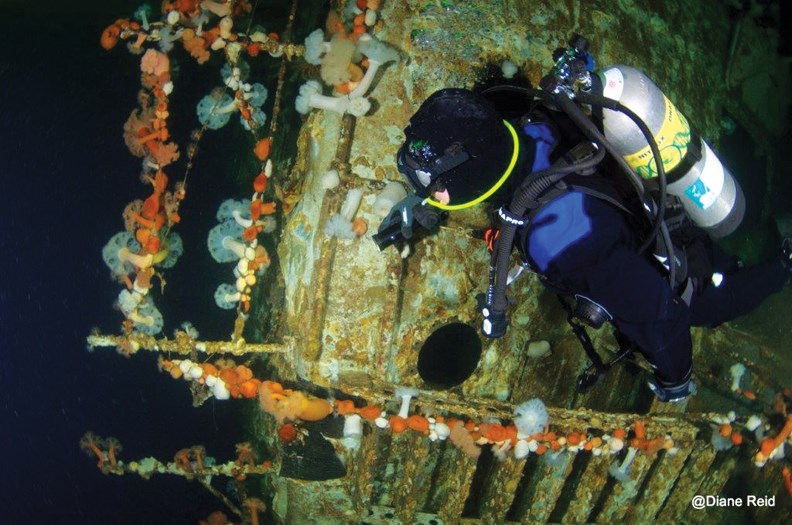She was born in the 1950s in Halifax’s shipyards, and in 1992 her life came to an end at the bottom of Porpoise Bay off Kunichin Point. The HMCS Chaudière didn’t sink on her own, though – it was a planned event orchestrated by the Artificial Reef Society of BC (ARSBC), with the help of Porpoise Bay Charters and more than 100 volunteers.
On Dec. 12, the ARSBC assembled a group of 11 die-hard divers to spend the day at the site of the Chaudière to celebrate the 25th anniversary of its sinking.
Divers took videos and photographs of the ship, also known as an artificial reef, and mended two floats and lines that divers use to descend to the wreck. “It’s always fun to put a little bit of a mission into the dive,” said Howie Robins, president of the ARSBC.
He hadn’t seen the Chaudière for 15 years, even though he was one of the people who helped sink it in 1992. “It was a little like coming home,” he said.
Porpoise Bay Charters, a SCUBA diving charter operation and longtime caretaker of the ship, sponsored the event and also brought staff from two Vancouver-based dive stores, Ocean Quest and the Diving Locker, to celebrate the anniversary. “It’s a funny feeling. We opened the business in Sechelt Inlet in 1990. After getting the Chaudière it was a fantastic amount of work, but it was very, very pleasing 25 years later to be out taking multiple groups and work crews out to the ship after all this time,” said Kal Helyar, of Porpoise Bay Charters.
The ARSBC bought the ship from the Minister of Defense in the early 1990s for $1.13, including tax, on the agreement that the group would transform it into an artificial reef. Helyar worked with ARSBC to raise $30,000 needed for the project, while 110 volunteers helped ready the ship. The 3,000-tonne vessel was the largest ship the ARSBC had attempted to sink at the time and it ended up falling to its side as it sank rather than landing upright on its keel as the crew intended, creating more disorienting conditions for divers who choose to explore its interior. “They’re giant canoes,” said Robins, “there’s some real physics going on when you sink a ship.”
Those who made the trip took two dives averaging 45 minutes each, enough time to travel around the exterior of the 111.5-metre-long destroyer. It was a sunny day with “magnificent” underwater visibility, giving the divers a clear view of the underwater vessel, though Helyar noted it’s best for divers to stay on the outside of the ship. “The ship is still in very good shape but it is no longer advisable to go into the ship any distance at all,” due to deterioration and the build-up of silt.
The Chaudière may be dead in the water, but it has also become the source of new life as a reef slowly grows around the vessel.
“What was very interesting going to see the ship once more was the abundance of marine growth and particularly the abundance of sponges,” Robins said. The crew also saw large ling cods, many species of rockfish and invertebrates.
While no impact studies are being conducted on the Chaudière, the HMCS Annapolis, another ship-turned-artificial reef by the ARSBC, is being monitored through the Annapolis Biodiversity Index Study in conjunction with the Vancouver Aquarium. Robins said multiple studies have shown that over time artificial reefs accrue a net benefit of marine life.
The next major project for the ARSBC involves working with the Catalyst Paper Corporation, a pulp and paper mill in Powell River, which owns 10 U.S. surplus ships, most built in the Second World War. The ships are chained together nose to tail to create a floating breakwater to protect the company’s log pond. In the new year, ARSBC will sink one of those ships with plans to sink four in total, all in one area, to create a cluster of reefs for divers – and fish – to enjoy.



